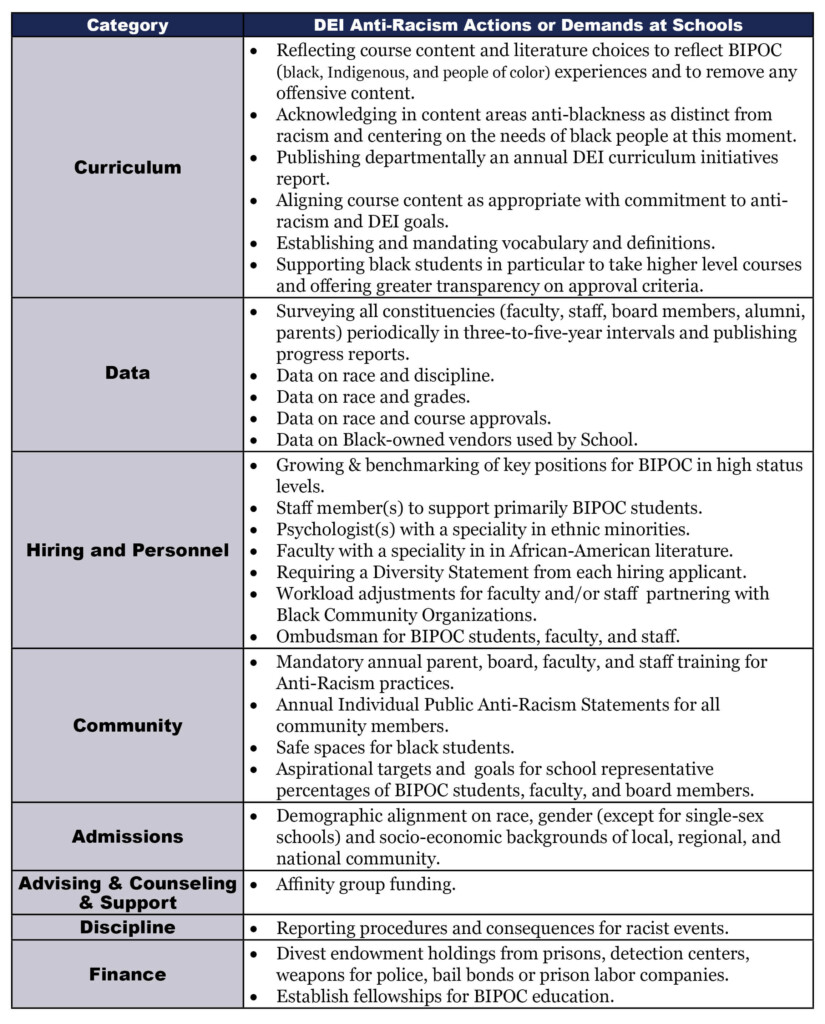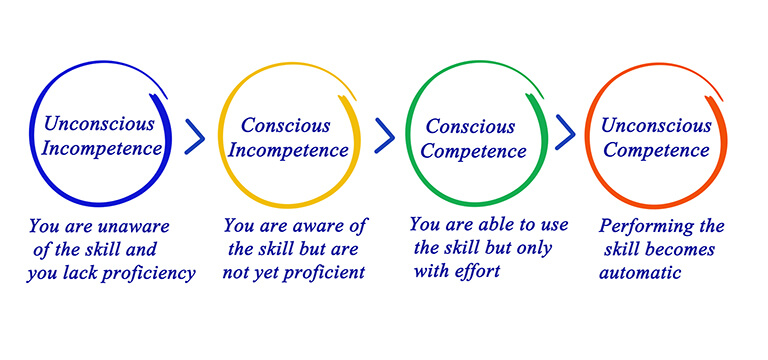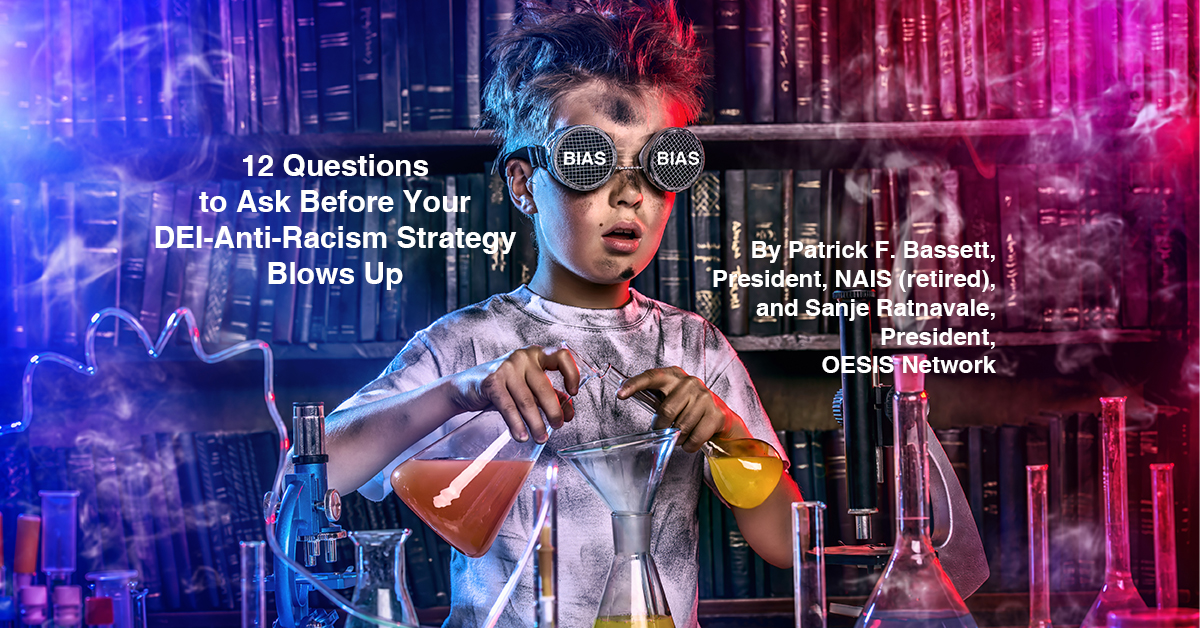July 1, 2021
By Patrick F. Bassett, President, NAIS (retired), and Sanje Ratnavale, President, OESIS Network
In some private schools the hunger for redemption regarding historic racism has unleashed a feast for journalists and Twitterati, eager to prove their role as arbiters of hypocrisy and lighthouses of virtue. Nevertheless, well-intentioned DEI (diversity, equity, & inclusion) plans are being hatched across the country, and they are focusing for the most part on allegations of systemic racism at schools. Systems thinking and systemic change acknowledge Newton’s Law that every action has an equal and opposite reaction. It is in this context that the authors write together for this magazine (for a second time in the last year), not just to identify pitfalls but to offer solutions. We are not here to opine on the need for an anti-racist canon at your school (any more than we would deign to critique any religious underpinnings at a parochial school) or whether antiracism itself forms an acceptable mission or valid set of purposes. We are here to look at the implementation approach critically from an educator lens, not a doctrinaire perspective.
We start with the spectrum of demands and actions that schools have contemplated around DEI or been asked by teachers, students, families or alums: We compiled this list from primary sources that we have obtained from multiple schools. We then look at the questions school leaders should ask, the consequences, intended and unintended, that might dovetail with these initiatives, and the implications for the type of schools they may then become.

- Will different curriculum choices move the needle on anti-racism? The program actions and demands above seem largely focused on curriculum, rather than assessment or pedagogy. It imagines that different content will help change the equation. But what is being assessed? The content or the skills? Is being anti-racist more of a skill or is it more of a content standard? One of the central premises behind the new anti-racism movement is that pre-modern narratives and power structures failed to register the actual experience of racism and its continued impact. It would then be more than a little ironic to use the same pre-modern tool (curriculum) that is associated with embedding or indoctrinating western narratives of white supremacy and western triumph, to move the needle. Given that anti-racism is largely a structural analysis, the lens may be more properly focused on the structure that is the program rather than the content of the curriculum. A 20th-century solution is more than likely to produce 20th-century results. Critics might argue that new narratives simply substitute one form of indoctrination with another.
- What type of program is more in keeping with the realities of racist experiences? The answer is Post-Modern pedagogies associated with deeper learning: inquiry-based learning, project-based learning, experiential learning, social-emotional learning, and competency-based learning. Inquiry-based learning offers students a more experiential, discovery-based learning environment, but when done properly is associated more with student curricular choice, projects, and driving questions. These might include questions like: “Have white power structures embedded racism?” or “Why are attitudes towards smoking or sexism poorly correlated with behavior?” or “Why have democracies failed to deliver on equality?” or “Does behavior in school and work translate into behavior personally, and if not why?” The New Zealand high school curriculum centers its experience around just such questions and projects that drive all learning. No one gets to choose the curricular path, or the texts, and teachers only offer choice and guidance. It also avoids the criticism of education tending towards indoctrination because it starts with a question, not a narrative. Most U.S. schools offer this kind of student-driven learning at the margin because it is too difficult to make central without sacrificing content or altering the schedule. Here then is a real opportunity and justification to make it central and embedded.

- What type of assessment will suit a skill like anti-racism? Many schools and educators have come to the conclusion that cognitive and non-cognitive competencies can be taught and assessed. The latter include such skills as kindness, empathy, and courage.
OESIS Network Leader Tara Quigley actually assesses empathy through a Beowulf inter-disciplinary project, where students collaborate to create gifts for characters in a maker space, present them to peer teams representing a character, and write letters of gratitude from the receiving character’s perspective: this is for a 5th/6th-grade Humanities class at Princeton Day School (NJ).
These skills are not content-centric skills; rather, they are inter-disciplinary competencies that need to be assessed with performance indicators. In this way, they become habits of mind, dispositions, and life-long attributes rather than soon to be forgotten content or attitudes that don’t register with behavior. Self-awareness itself could be fashioned into a skill. A combination of such non-cognitive competencies, along with cognitive competencies like communication, collaboration, and empathy (the key element in EQ, emotional IQ) may be a better prescription for consciously or unconsciously addressing racism.
- What are the purposes of education as defined in your mission, and do your parents really buy into them as part of the brand promise? Potentially, the biggest unknown may be that you drink your own Kool-Aid and believe that your parents place the mission of the school above the self-interest that motivates them to open their wallets and enroll in your school. Test it. Ask a group of parents without warning to write down the mission of the school and then ask them to write down what they want from the school. And do the same for your students and faculty. You may be surprised. DEI plans range from a focus on student opportunity to equal outcomes to activism for civic change to a redefinition of student values or morals. Ensure alignment with parent expectations before taking the first step. Parents tend to be very pragmatic, particularly when their wallets are concerned, and often view DEI or any new initiatives as stealing time from the school activities they value.
- Did you define equity as equal opportunity or equal outcomes? Opportunities are ways to equalize starting points, while outcomes are validated results. Equity as a definition ranges between these two elements. Thus, excluding the gladiatorial games in Rome and the subject of mortality, there is no human experience or system, to our knowledge, that has established a track record of equal outcomes in history. Nevertheless, if this is your path, then it’s important to identify what fair outcomes your school can point to in the past.
Certainly not standardized tests like the SAT and ACT. Standardized tests across the public and private school and college spectrum have no track record of fair outcomes in a DEI context; in fact, the reverse is the case. With the SAT and ACT now increasingly optional for colleges and universities, standardized admissions testing in the idealized future of independent schools should be a pathway to individualizing specialized tutorial assistance for any incoming students, not as justification for non-acceptance of students whose school performance to date may not yet be stellar.
Are you, like some or most of your current and prospective parent customers, defining ideal outcomes of your school as a significant factor in admission to prominent secondary schools and/or for entry into elite colleges and universities or, more simply, direct access for pathways to a child’s life-success? Is such a preferred pathway for graduates seen as essential to your schools for building your school’s prestige, ultimately the driver justifying your high pricing? If so, is your DEI plan perpetuating inequality and exclusivity, rather than diminishing it? Are you jeopardizing your school’s DEI’s success by over-reliance on the unknown and opaque admissions processes of schools and colleges that are themselves bastions of inequality? How do you sell the social, life-long benefits of diversity as a key salubrious outcome to supporting your school?
Are you defining outcomes as placement into honors or AP courses that show students have reached higher levels of learning? This is more akin to opportunity than outcomes and includes the necessary support that you have at your control to deliver. Having said that, the thrust of education is moving away from such tracking and away from content-intensive highly sequenced courses, favoring as they do wealthier prepared students or schools better able to access and afford teacher talent. The research also shows that alongside greater teacher support for less well-prepared students, the emergence of a growth mindset may be key to better student performance. That is a complex deliverable that should probably be featured in an opportunity-centric DEI plan.
- What is the longitudinal evidence regarding anti-bias training and significant outcomes of eradicating bias? Sadly the evidence from the corporate world regarding unconscious bias training research in the workplace is discouraging and frustrating and is showing weak results. Schools undoubtedly need to be held accountable in ways that they were not before, but may also need to accept at least temporarily that the key to combating implicit bias is related to a healthy, inclusive, supportive culture at the school, not just sporadic training.

Assessing a true inclusion norm baseline is fundamental, as shown in the chart above. See a sample of a leading normed survey for schools developed by Six Seconds using its Education Vital Signs tool.
Data should inform required elements of any DEI plan and actually any type of accreditation where culture and equity are key elements, as would always be the case for independent schools. For example, assessing a true inclusion baseline is fundamental, as in the chart above from a leading normed survey for schools by the SEL non-profit, Six Seconds. Schools have deployed climate assessments but very few have used normed inclusion assessments. Yet they exist with all the psychometric rigor to give them validity. Ultimately, each community is unique, and you will have to build your data-validated indicators that confirm a change in behavior, perspective, and more.
- Did you think that you could leave it to the DEI Director you just recruited to come up with a plan? Recruitment as a way to manage new initiatives has been the de facto historical solution to virtually every problem at independent schools. This may not work in the way it has in the past because the era of independence (with teachers and administrators employed for their siloed domains) has been replaced by a future of hyper-collaboration, data, and agility. The new context brings social-emotional skills and emotional intelligence to the fore. DEI Directors have had a very limited shelf life recently, with our experience pointing to a couple of years as the emerging standard. Think about why that may be the case. Is it because they become a lightning rod without sufficient support? Is it because they come in with a prescriptive plan before fully understanding the school culture? Is it because the school itself has not done a proper assessment of its need and capacity for change? As recent school blow-ups are showing, the market for Interim Heads of School is also exploding. Soon a correlation is likely to appear between HOS shelf lives and the timing of DEI Director recruitment if it has not already. Make sure, therefore, that the timing of your DEI plan begins with an honest assessment of capacity at the leadership level, rather than with recruitment.
- Did you take a look at the culture of leadership that you have created? If you are serious about a DEI plan, either delay other major initiatives or make sure your DEI plan achieves more than one objective, such as reinventing your program and school policies. Most culture change at organizations fails because the capacity for change is lacking. What is going to bring about a successful plan at your school will be, more than anything else, the ability of the school leadership to bring together diverse communities and interest groups. School leaders have a number of challenges in this domain including the following: 1) They have generally been removed from the day-to-day learning decisions to focus on the myriad of other responsibilities from finance to fund-raising; 2) They have operated on a need-to-know basis for most constituencies, hardly a trust-transparency model; 3) Too few leadership teams in any organization are in sync or have the level of trust or capacity to make such a significant pivot; and 4) Committees are generally perceived as tools for delaying or avoiding issues until they fade into an enthusiasm black hole.
- What might be the tools of opposition and cancel culture? For each pressure group that fights your plan, there will be a tool of choice, some passive-aggressive tools, and others “in your face” tools. For parents, there will be extensions requested for re-enrollment, and we have seen these at some of the high-profile school blow-ups featured in the press, along with large-scale boycotts of annual funds and more. For teachers, be prepared for the likely emergence of unionization that emerged as a threat, appearing nationwide over COVID-19 reopening. For students, you can expect everything from social media shaming that has been seen in the last 12 months, to leaks, school newspaper criticism, boycotts, and more. Activism is part of the American social construct.
- School change is expensive. Do you have the budget? From hiring to professional development to parent education to extra financial aid to new programs, surveys, and data initiatives, most DEI plans will incur substantial expense over some time period. Even assuming you have some flexibility in your budget, have you considered what will be taken away to offset the new financial commitment and the impact the loss will have. Schools have been great at adding new programs because it looks like they are at the forefront of change. Removing programs and initiatives is not as easy.
- What will happen to your teaching supply chain? Parents often have little idea of the complexity of school decision-making and how the parts affect each other. There is a sub-text in many of the demands and actions from external constituencies that grading has been racist, teachers are biased, their grading is biased, there is racism in compensation levels, and teachers need to be held more accountable. What could be a better set of grievances for driving away your teaching staff, who not only pride themselves on the nobility of their motivations but also value their independence? If some of the demands or actions impact your ability to retain or recruit faculty, be very careful about not only the timing but also the acceptance of your DEI changes. There is very likely to be an exodus from the teaching profession in the next few years, and you have nothing if you lack an experienced and talented teaching base.
- Should the focus be on the wide spectrum of students and citizens of color as the most pressing DEI focus? We are interpreting some of the demands made to schools as making the point that racial discrimination is a more pressing need in the larger issue of equity and inclusion. This requires little explanation given the history of this country or recent events, but it does open to debate the true intersectionality of all traditionally disadvantaged groups. It goes back to the purpose of education in your school: if your mission is more civic-oriented and potentially political or democracy-focused, then such a selectively-focused DEI plan makes sense
.
Conclusion
Systemic change at schools of any ilk has been a challenge, complicated by cascading trade-offs between schooling and learning. Identifying if systemic racism exists and then developing an approach to combatting it is no different from identifying if systemic lack of learning exists, and then finding ways to enabling learning. It must be deep, it must be engaging and relevant, it must be fair and open, it must be transformative and life-long in impact, and it should be the responsibility of a community that cares. Even if you are able to pivot your mission to emphasize equity and inclusion and garner the appropriate alignment of constituencies with the mission, the road ahead will still be a challenge.
Other Intrepid Related Articles & Resources:
- What is your real Plan for DEI?
- Clash of Ideologies What’s driving your School of Thought?
- The Connection between Antiracism and Learner Centered Education.
- Will Accreditation Survive COVID-19 and Racism?
Write a letter to the Editor on this article: [email protected].

